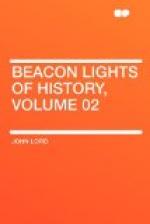The other laws which Moses promulgated are more special and minute, and seem to be intended to preserve the Jews from idolatry, the peculiar sin of the surrounding nations; and also, more directly, to keep alive the recognition of a theocratic government.
Thus the ceremonial or ritualistic law—an important part of the Mosaic Code—constantly points to Jehovah as the King of the Jews, as well as their Supreme Deity, for whose worship the rites and ceremonies are devised with great minuteness, to keep His personality constantly before their minds. Moreover, all their rites and ceremonies were typical and emblematical of the promised Saviour who was to arise; in a more emphatic sense their King, and not merely their own Messiah, but the Redeemer of the whole race, who should reign finally as King of kings and Lord of lords. And hence these rites and sacrifices, typical of Him who should offer Himself as a sacrifice for the sins of the world, are not supposed to be binding on other nations after the great sacrifice has been made, and the law of Moses has been fulfilled by Jesus and the new dispensation has been established. We see a complicated and imposing service, with psalms and hymns, and beautiful robes, and smoking altars,—all that could inspire awe and reverence. We behold a blazing tabernacle of gold and silver and precious woods and gorgeous tapestries, with inner and secret recesses to contain the ark and the tables of stone, the mysterious rod, the urn of manna, the book of the covenant, the golden throne over-canopied by cherubs with outstretched wings, and the mercy-seat for the Shekinah who sat between the cherubim. The sacred and costly vessels, the candlesticks of pure and beaten gold, the lamps, the brazen sea, the embroidered vestments of the priests, the breastplate of precious stones, the golden chains, the emblematic rings, the ephods and mitres and girdles, the various altars for sacrifice, the burnt-offerings,




